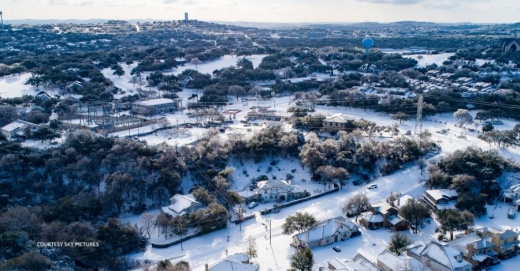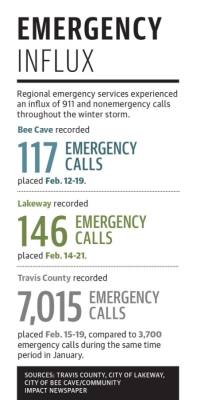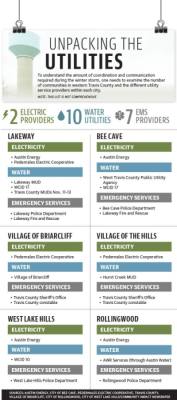The cascading effects of the weather on western Travis County, with basic electric and water service failing and icy Hill Country roads preventing safe travel on area roadways, tasked local government officials to pull together multiple arms of state and local government. In doing so, local leaders say they grappled with the unique challenges of west Travis County.By 8:30 a.m. Feb. 15, the weather service reported more than 7 inches of snow had fallen over Lakeway, and regional electric utilities, such as the Pedernales Electric Cooperative, were announcing service interruptions amid record demand for power.
Lakeway officials were beginning to coordinate efforts with neighboring Bee Cave. Over the course of the week, these city leaders would meet twice a day with area emergency response agencies and local utility officials to triage problem areas. Of particular concern were neighborhoods like Serene Hills and Falconhead West, which lost water service due to the electric outages and freezing equipment.
Those constant connections with local leaders ultimately proved successful as area officials worked together during a frightening period of time when electricity was out, Lakeway Mayor Sandy Cox said.
”If you lost power completely those homes got really cold, and for the elderly and those with kids that was a very scary time because you didn’t know when it was going to come back on,” she said. ”We came together. This was a regional effort. It’s Lakeway. It’s Bee Cave. It’s Lake Travis Fire & Rescue, and all the utility districts—all working together for this area.”
Advocating for west Travis County
Also, taking part in those daily calls was Ann Howard, who represents Precinct 3 on the Travis County Commissioners Court. If anything was made clear by the winter storm, it was the importance of coordination among the communities of western Travis County and the county’s Emergency Operations Center, Howard said
“I did advocate for the west part of the county and the southwest part of the county because they didn’t have their own advocates,” Howard said. “I realized some of the smaller cities were not very connected to that EOC, and the cities have membership on the EOC. We made a connection between Rollingwood and the EOC, and we made a connection with Bee Cave and the ECO.”
Rollingwood Mayor Michael Dyson said Howard’s efforts along with a culmination of other local officials were instrumental in the city’s storm recovery efforts.
At one point during the storm, roughly 90% of Rollingwood dwellings were without electricity, according to Amber Lewis city administrator.
The small community outside of the city of Austin faced a series of unprecedented challenges. The blackouts, which lasted until Friday, impacted six of Rollingwood’s seven wastewater lift stations, which pump sewage out of the city.
Rollingwood’s 16-year water utility operator, AWR services, was unable to reach the city due to icy conditions. City officials were left with little assistance from AWR, necessary generators or expert knowledge of water system operations. Lewis said at times Rollingwood staff felt desperate.
Officials were dangerously close to turning off the city’s entire water supply to avoid an overflow of the wastewater system, which would have flooded raw sewage through city streets and into direct channels of Lady Bird Lake, according to Dyson.
It was an all hands on deck moment for Rollingwood, one that he said was made easier by officials such as Howard.
“I don’t know how to explain how helpful they were in making sure we were able to communicate the critical nature of our needs in our city to some of the folks that really needed to hear it,” Dyson said during a Feb. 24 city council meeting.
Further west in the Lake Travis region, state Rep. Vikki Goodwin, D-Austin, was working to assist her own constituents, many of which were struggling without water or heat.
Goodwin said she never anticipated electricity outages of the magnitude Texans experienced. In addition to these challenges, she said early communication from state agencies did not reflect the gravity of the natural disaster.
Even as a state representative, Goodwin was at one point unaware of who was in charge of allocating aid. When the Federal Emergency Management Agency sent water to Travis County, Goodwin scrambled to advocate for western residents.
“I had to advocate for western Travis County because there wasn’t a plan really to get [water] out to the Lake Travis area,” Goodwin said. “It took a lot to get water out there and to really understand where the pockets were that were hit the hardest.”
Goodwin said it can often be difficult to advocate for the needs of suburban communities outside of the city of Austin—a challenge is exacerbated amid an emergency situation.
“I think that oftentimes the county looks at Lakeway and some of the other areas in my district as being affluent and having resources and so they tend to get overlooked. We really need to rectify that,” she said.
One example of this pertained to a mobile home community near Hudson Bend. Residents there were in dire need of water and food, according to Goodwin, who used her relationships with public officials to distribute resources to the community.
Having resources distributed out into the community was the result of a collective decision made as area residents sat at home without basic utilities. And that decision was to not open shelters. Hazardous driving conditions and unpredictable utility service played a role, Cox said.
“Once we realized the energy issue with ERCOT, we couldn’t with reasonable confidence know that even if we could get people there, that it would have power,” Cox said. “In the heat of the moment, you don’t know, you make the best decision with the information you have.”
While city-sponsored shelters did not materialize, Bee Cave Mayor Kara King did turn to the community. She posted regular updates to the city’s website and Facebook page keeping residents informed on efforts to shuttle heating fuel and water to the most impacted areas. She also circulated a sign up sheet, she dubbed Neighbors Helping Neighbors, so that residents could offer up their homes for shelter.
Also, Cox said local residents who had the vehicles that could handle the snow-covered roadways shuttled drinking water to those in need.
”We didn’t see borders out here. Both cities were working on Travis County issues as a unit,” Cox said. “We’re isolated, and we’ve got these wonderful, rolling hills and this beautiful Hill Country, and when it freezes over, it’s difficult to get here. We knew we had to solve our own problems.”
Emergency efforts
The challenging topography effectively cut off western Travis County from necessary aid as Hwy. 71 and RM 620 completely iced over. The region’s rolling hills created challenges for emergency service providers, who were experiencing an influx of 911 calls throughout the week’s winter storm.
Travis County Emergency Dispatch received 7,015 emergency 911 calls as a result of the inclement weather, compared to 3,700 calls during the same time period in January, according to Maj. Craig Smith of the Travis County Sheriff’s Office. Dispatch received an additional 4,460 non-emergency calls.
Lake Travis Fire and Rescue saw a comparable surge in emergency calls, according to Capt. Glen Trubee.
“The demand has been very, very high. We have extra staff assigned and [we’re] extending shifts as needed,” Trubee told Community Impact Newspaper.
In West Lake Hills, many of those calls were from drivers who had slid off the city’s narrow and winding roads, Police Chief Scott Gerdes said.
Dispatch received more than 50 calls related to these incidents. There were multiple car pileups on several days, according to Mayor Linda Anthony who said thankfully no significant injuries occurred.
While the region’s topography made rescue efforts more difficult, it also impacted rescue crew’s ability to make it home to their own families at the end of the night. Officers in West Lake Hills and Rollingwood slept in the police buildings for several nights in order to serve the community, Anthony said.
“Our police department and the Westlake Fire Department just came through with flying colors over and beyond what we could have ever imagined,” Anthony said.
The Westlake Fire Department played an instrumental role in allowing resources and aid to reach the city, Anthony said. Without salt trucks, it was up to the local fire departments to sand and clear the slick roads.
“I have heard anecdotally that Austin Energy crews just had trouble navigating some of our streets. When they came to restore the power at [Water District 10’s McConell pump station], Thursday, they would not have been able to access it had the fire department not gone in first,” Anthony said.
An opportunity to look forward
Hit hard by the confluence of freezing temperatures and power outages was Water Control and Improvement District 17. The utility wrestled with failing equipment and freezing pipes as its customers, particularly along hilly Serene Hills Drive, faced dual power and water outages.
Understanding what exactly happened and why interconnections with surrounding water utilities did not provide adequate widespread relief is currently being studied by staff, said Jason Homan, general manager of WCID 17.
“We are still going through our after-action report and that will be a five- or six-week process for us,” he said.
One factor was the hills within neighborhoods such as Serene Hills that lost water service. Addressing adequate backup systems requires building pumps and water tanks, he said.
“It has a lot of topographical challenges,” he said. “It’s expensive to move water every time you have a large hill in the way.”
On a positive note, Homan said he agrees with city officials that coordination was important and successful. At one point, the neighboring Hurst Creek Municipal Utility District stepped forward to serve 75 of WCID 17’s customers while WCID 17 worked to restore water to Baylor Scott & White Medical Center.
Once a review of the events like these that took place during an emergency situation are complete, city, county and utility officials will need to decide the level of preparedness and the frequency of investment necessary for an area of Travis County that is rapidly urbanizing.
“The area we are in was very rural, and now we have this urban sprawl that has linked all of these communities together,” he said. “And that presents challenges because they are not centralized. Our boards and county leadership are going to have to decide what level of resiliency we are comfortable with because with resiliency comes a cost.”
Moving forward, Goodwin is also focused on the development of emergency preparedness. She is working on a bill that would ensure expanded emergency plans and communication efforts. The bill would also require power companies to weatherize their grids in the event Texas sees another ice storm.
In addition to the electricity outages, Goodwin said there was at times a terrible lack of communication.
The sheer number of utility providers in western Travis County proved difficult when trying to streamline information for customers. While this infrastructure cannot be changed, Goodwin is advocating for more phone alert systems.
She said every electricity and water provider should have the ability to contact each customer in an emergency situation.
“This certainly was a situation that was worse than anyone anticipated but that’s exactly what an emergency plan is for. You are supposed to anticipate what could be the worst-case scenario and how do we address it,” Goodwin said.








